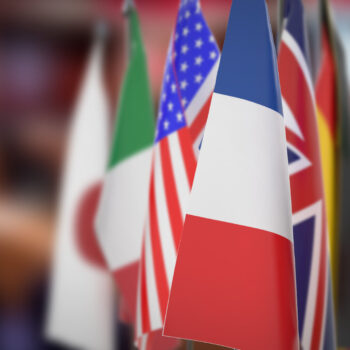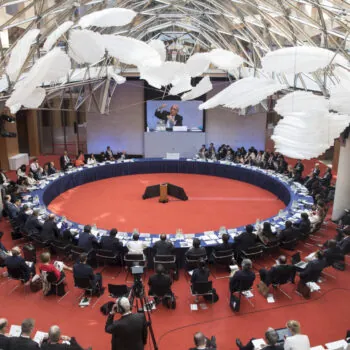Part I – Setting the 2021 Climate Diplomacy Agenda
With the return of the US to the climate club and European climate leaders holding the reins of this year’s major geopolitical processes, the stage is set for an ambitious climate diplomacy agenda this year, culminating at the UN COP26 Climate Summit in November. But in a political and economic landscape dominated by the COVID-19 crisis, successful global climate action will depend on weaving climate considerations as a golden thread through diplomatic efforts on global health solidarity and economic recovery.
2021 is a historic year for global climate action. The scale of economic and social change resulting from the COVID-19 crises presents an opportunity for transformational outcomes. Major decisions taken by governments on their economic recovery investments and their willingness to work together to address global crises will set the trajectory for climate action for the next decade. COP26 will be the first time in two years that world leaders come together to assess progress on climate action – the first real litmus test of the Paris Agreement.
Of course, uncertainty is the only certainty. We don’t yet know how COVID-19 lockdowns will roll over 2021, when and where diplomatic travel will restart, and how COP26 itself will shape up at the end of the year.
What we know for certain is that 2021 has the potential to start shaping a better global economic system. One that is more resilient and fairer as well as green. We must seize this to re-set how our economies work. If we fail to grasp this, we risk locking in an unjust and dirty economic system for the long-term.
Creating the right conditions for climate action in 2021
The complex political and economic context of 2021 demands action outside of the climate space to create the right conditions for successful climate outcomes. With the challenges of COVID-19 recovery and solidarity, we need more action outside the climate space than climate actors are used to driving.
1 – Building the politics for cooperation: Firstly, this year’s climate diplomacy agenda cannot exist in isolation from a geopolitical environment defined by tensions among world leaders and intersecting health, climate and poverty crises. Achieving climate progress depends upon reigniting global cooperation to address global challenges. The COVID-19 pandemic has thrown light on interlinked economic, social and environmental vulnerabilities – for example, the challenge of working together to get the global population vaccinated in a timely and equitable way, and the fragility of global supply chains and their impacts on food security and livelihoods of producers. Yet confidence in deploying multilateral solutions to these shared global challenges has been rocked by years of isolationism from major powers.
Climate solutions can also be central to addressing interlinked economic, social and environmental challenges.
The UK and Italy have a unique opportunity, between them sharing the G7, G20 and COP26 Presidencies, to drive global action on the existential threat of climate change – a rare area of common global interest amidst geopolitical tensions. Showcasing shared action on climate change can be a means of demonstrating global cooperation and building confidence among world leaders on the prospects of multilateralism. In this way, climate action can facilitate cooperative geopolitics to address wider challenges that 2020 has exposed to world leaders. Climate solutions can also be central to addressing interlinked economic, social and environmental challenges.
2 – Creating solidarity for prosperity: economic recovery from the impacts of COVID-19 is a top priority for global leaders this year – but for many countries this conversation is premature. Many developing countries are facing liquidity problems or are on the brink of insolvency, with limited fiscal space to build back, let alone build forward in a green way. What’s more, the economic and public health impacts have been hardest on the world’s poorest countries, which are also those most vulnerable to climate change.
Global South and Global North leaders must work together to create the foundations for prosperity for all. Solidarity will be crucial to creating a positive political context for COP26 to make real progress on the thorny issues high on the climate diplomacy agenda. Solidarity must start with COVID vaccine generosity – no country is safe until all are safe. Ensuring access to recovery finance for all will be a key condition for climate action in developing countries, as well as for building solidarity between developing and developed countries.
The immediate challenge is to ensure that all countries have the fiscal space both to provide essential public services and to lay the foundations for green recovery. G20 countries should expedite issuance of Special Drawing Rights (SDR) by the IMF and their distribution to developing countries. Debt relief should be extended, and an orderly restructuring process agreed by creditors where needed. The financing capabilities of Multilateral Development Banks should be increased so these institutions can make countercyclical investments and deliver the up to $700bn USD required globally in increased annual external financing needs for developing countries to recover. All of this should be underpinned by co-designed longer–term policy solutions and backed by credible, significant commitments on concessional climate finance – particularly for adaptation.
Ensuring access to recovery finance for all will be a key condition for climate action in developing countries, as well as for building solidarity between developing and developed countries.
3 – Greening COVID-19 recovery: these foundations for prosperity and solidarity are also key for world leaders to deliver a green, fair, resilient, and truly global recovery. To advance climate action in 2021, world leaders must align economic recovery investments with the goals of the Paris Agreement. The global narrative has already been won over “green recovery”; the challenge now is to win it in practice. Leaders’ efforts should be judged on the amount of money that is flowing into green investments, avoiding unsustainable economic activities, and credible restructuring of economies, not rhetoric in speeches. Setting standards that define sustainable economic activity can accelerate recovery and build the global green markets of the future, whether in electric vehicles or digital technologies.
At the national level, public and private finance reform should mainstream clean economies for the long-term and shift away from unsustainable activities by developing strong Paris-aligned conditionality on stimulus spend and minimum floors for spending on green activities. At the international level, cooperation this year to achieve systemic economic and financial reforms can potentially put the global economy on a Paris-aligned path for years to come. Key opportunities include reform of the IMF to address climate within assessment and lending processes, and more deeply integrating climate risk management into financial supervision of credit and insurance.
Combining all these to underpin the climate action agenda: In 2021 governments need to show – in their COVID responses as well as their climate policy – that they are taking their Paris promises seriously and enabling the whole of society to deliver on all pillars of the Paris Agreement: emissions reduction to mitigate climate change, addressing climate vulnerability, and shifting finance flows.
COP26 will be the judgement moment on how world leaders have shifted political ambitions and their economies in line with the Paris goals. It is the moment to demonstrate the irreversible momentum of ambitious climate action and climate diplomacy. It also provides the space for strengthening the climate ambition ratcheting cycle in a way that set us up for the decade of accelerated action needed over the 2020s.
So what are the proof points for climate action in 2021? And how can all of this be delivered? Read Parts II and III of this blog series:


